- Home
- Lynne Olson
Those Angry Days Page 12
Those Angry Days Read online
Page 12
Dismissing Borah’s admonitions, the pro-administration senators who spoke for the bill followed Roosevelt’s lead in never mentioning the need to help Britain and France and in insisting that repeal of the embargo was the best guarantee of peace for America. By doing so, the historian Robert Divine observed, they continued “the elaborate pretense that the sale of arms to the Allies was but an accidental by-product of a program designed to keep the United States clear of the war.”
Although congressional isolationists prolonged the debate for as long as possible, theirs was clearly a losing fight, especially when the administration, in a nod to isolationist sentiment, agreed to retain the Neutrality Act’s provision prohibiting American vessels from entering war zones. In the Senate, southern conservative Democrats joined their northern liberal colleagues to vote for the embargo’s repeal; the final tally was 63 to 30 in favor of the legislation. The House followed suit with a similarly top-heavy margin. In both houses, most of the negative votes came from the Midwest and West.
Afterward, an elated Cordell Hull declared: “We have won a great battle.” But some isolationists argued that the administration’s triumph was in fact a Pyrrhic victory. “Because of our battle, it is going to be much more difficult for FDR to lead the country into war,” Senator Arthur Vandenberg, a Michigan Republican, wrote in his diary. “We have forced him and his Senate group to become vehement in their peace devotions—and we have aroused the country to a peace vigilance which is powerful.”
A number of proponents of the embargo’s repeal, meanwhile, expressed dismay at the repeated arguments of the president and his congressional allies that its enactment would help keep America out of the conflict. Dorothy Thompson, for one, complained that the American public had been promised “more security than it is wise for them to think they can have. Not a single people in the world today is safe.”
Roosevelt waved aside all such criticism. He responded coolly when the literary agent George Bye, a friend of the Roosevelts, passed on a letter from an acquaintance that said in part: “Why don’t you tell our idol FDR to quit beating around the bush, to get on the radio and be honest with his people? … Of course, we cannot afford to let France and England get licked. Of course, we should prepare to help them—first with munitions and then, if that is not enough, with everything we’ve got. Why stall around? Why let these pussyfooting Senators kid the American public into the belief that we could stay out of another war? Why not talk brutal realism to the American people before it is too late?” Clearly unmoved, the president instructed his secretary to respond with a boilerplate expression of thanks: “Say I was delighted to get it.”
After the twin disasters of the Court fight and congressional purge, Roosevelt had yet to recover his once buoyant assurance that the American people stood behind him. Throughout the next two years, to the consternation of his allies in the intervention fight, he would repeatedly refuse to assume the mantle of bold leadership he had donned in the early 1930s. And whenever he did take a step toward greater involvement in the war, he invariably did so, as the historian Richard Ketchum observed, “with an uneasy backward glance to see if the opposition might be gaining.”
CHAPTER 7
“PARANOIA CAN BE CATCHING”
With the repeal of the arms embargo in September 1939, life in the United States quickly returned to normal. Congress adjourned, the president went on vacation, and Americans relaxed, confident in the belief they had put the specter of war behind them.
Events—or rather the lack of them—reinforced that view. The Allies’ declaration of war against Germany apparently hadn’t meant what it said. This putative conflict was, as Life pointed out, “a queer sort of world war—unreal and unconvincing.” There had been no fighting in Western Europe, no German air raids over Paris and London, no Allied air assaults on the Ruhr. Having supposedly gone to war over Poland, Britain and France did nothing to help save that tortured country except send a few token patrols across the Maginot Line and fly a few reconnaissance flights over German territory. In Britain, the phantom combat was called the “bore war”; in France, it was the “drôle de guerre.” Senator Borah tartly dubbed it the “phony war,” the name by which it became known in the United States.
Most Americans had little doubt that even if the war did heat up, the Allies would easily win and their own country would escape involvement. According to the Denver Post, “the smallest domestic problem is now more important to the American people than the most momentous European crisis.”
In his State of the Union speech in January 1940, Roosevelt warned his countrymen about the perils of complacency, observing that “it is not good for the ultimate health of ostriches to bury their heads in the sand.” But he was hardly a role model for action himself. When the Soviet Union, now a quasi-ally of Germany, invaded Finland in November 1939, the president protested strongly, as did the American press and public. But the United States sent no material aid to the Finns in their David-and-Goliath struggle against the Soviets, even after the Finnish ambassador declared that the U.S. decision not to sell arms to his nation “would be tantamount to signing a death warrant.” Although not unsympathetic, Secretary of State Cordell Hull could only reply that the U.S. government would “not engage in acts or utterances that might materially endanger its peace and safety by causing it to be drawn into war.”
Such inaction infuriated Robert Sherwood, who wrote in his diary, “How long can the conscience of the U.S. remain dormant?” Inspired by the Finns’ desperate resistance, Sherwood began work in January 1940 on his first play since Abe Lincoln in Illinois. Entitled There Shall Be No Night, the drama, about a Finnish family caught up in the conflict, was meant as a protest against “the hysterical escapism, the Pontius Pilate retreat from decision” that, in Sherwood’s view, marked American public opinion about the war.
Written in a white-hot frenzy, There Shall Be No Night opened on Broadway in April and toured the country soon afterward. The public’s widely varying reactions to it vividly demonstrated Americans’ increasingly divided opinions about the war. In New York, protesters passed out leaflets headlined “Warmongers Capture the Alvin Theater” and describing the play as a “weapon pointed straight at the hearts of the American people.” In Philadelphia, picketers blocked the entrance of the theater in which it was playing, and in Chicago, the isolationist Chicago Tribune refused to print one word about it. Nonetheless, it sold out in every city on the tour.
In Washington, the syndicated columnist Raymond Clapper disapproved of Sherwood’s propagandizing—a “rank and inflammatory job”—but noted that the production “played to capacity audiences, which are traditionally undemonstrative here, and sent them away moist-eyed. Most … were swept off their feet.” One of those “moist-eyed” Washington playgoers was the president, who sent Sherwood a fan letter soon after he saw the drama. But Roosevelt’s enthusiasm did not translate into concrete help for Finland, which, unsupported by any Western country, was forced to capitulate to the Soviets in the early spring of 1940.
During this period, one historian wrote, “American foreign policy remained almost in a state of suspended animation, paralyzed by its avowed neutrality.” FDR and his advisers were sure that the phony war would not last—Germany was clearly consolidating its strength—but they felt powerless to do anything substantive to alter the course of events.
In March, Roosevelt sent Undersecretary of State Sumner Welles on a mission to Europe to explore the possibility of a negotiated peace. The only thing to come of Welles’s talks with Chamberlain, Daladier, Mussolini, and Hitler was an expression of anger by Britain and France over what they saw as U.S. meddling. To his colleagues in the British Foreign Office, Sir Robert Vansittart bitterly referred to the undersecretary as “an international danger.… His chief crime towards common sense and humanity is that he has now gone so far as to want us to make peace with Hitler.” Welles, for his part, acknowledged that only a U.S. pledge to provide all-out support for the Al
lies in the event of real war might have given Hitler pause. But, as everyone knew, the chances of that happening were nil.
Indeed, since the beginning of the war in September, the Roosevelt administration had made little effort to shore up America’s own defenses, much less mobilize to help Britain and France. In the view of the historians William Langer and S. Everett Gleason, Roosevelt seemed to have “considered repeal of the arms embargo a sufficient program for the moment [and] thought that this measure was about all that the public would accept.” Even the president’s plan to build ten thousand warplanes a year, which had so delighted Hap Arnold in late 1938, had been slashed by almost 70 percent.
With fewer than two hundred thousand men, the U.S. Army was still in pitiable shape, and General George Marshall urged Roosevelt to ask Congress for a substantial increase in military appropriations for the 1941 fiscal year. Marshall was doomed to disappointment: the administration’s request was slightly more than half the amount originally proposed by the Army’s top brass. In the late 1940s, Marshall would tell his biographer, Forrest Pogue, that if the United States had embarked on a full-fledged rearmament program in the fall of 1939, it probably could have “shortened the war by at least a year” and saved “billions of dollars and 100,000 casualties.” The former Army chief put much of the blame for lagging U.S. war production on Roosevelt’s reluctance to press Congress for a greatly expanded defense agenda.
But even if Roosevelt had been more aggressive in his requests, it’s highly doubtful they would have won congressional approval. FDR’s standing on Capitol Hill was still considerably diminished, and congressional leaders made it clear early in the 1940 session that they would probably make deep cuts in even the modest military budget that had been proposed. Pointing to the lack of fighting in Europe and focused on upcoming elections, members of Congress paid little heed to Marshall’s warning that time was running out for America. Due to “chaotic world conditions,” the Army chief of staff declared, the United States was certain to face critical military challenges in the near future, for which it was dangerously unprepared.
On April 3, the House Appropriations Committee slashed the administration’s proposed military spending by 10 percent. Six days later, thousands of German infantry and parachute troops, supported by warships and hundreds of aircraft, descended on Scandinavia, vanquishing Denmark in a day and laying siege to Norway. Barely a month after that, more than two million German soldiers poured into Holland, Belgium, and France, crushing the first two countries in little more than a week and trapping British and French forces at Dunkirk, on the northern coast of France.
THE PHONY WAR WAS clearly over, and Americans were in a state of shock. In New York’s Times Square, vast crowds watched in stunned silence as illuminated news bulletins atop the Times Tower headlined one nightmarish Allied defeat after another. The vaunted French army, supposedly the finest in the world, was collapsing like a house of cards, and the British Expeditionary Force faced extinction on the beaches of Dunkirk. Decades later, Americans who lived through the high drama of those weeks still found it difficult to put into words the panic and bewilderment they felt over what Roosevelt called the “hurricane of events.”
The German blitzkrieg seemed unstoppable. Soon, it appeared, America, whose immunity from foreign aggression had seemed a certainty just days before, “would be left, as the last great democracy on earth, to fight the war of the Western Hemisphere against a united German continent of Europe.” In his diary, Harold Ickes grimly observed: “There is no doubt in my mind that this country is in the most critical situation since we won our independence.”
Not since the worst days of the Depression had the country’s citizens been so uncertain, fearful, and confused. Aubrey Morgan’s survey group at the British Library of Information reported to Whitehall that there was “near hysteria in many sections of the U.S. press and deep anxiety in practically all.” According to a poll conducted for Fortune magazine, 94 percent of Americans were willing to spend whatever was necessary to make U.S. defenses secure.
On May 16, with public opinion solidly behind him, Roosevelt went before a joint session of Congress to request $1.18 billion in new military appropriations and to call for the production of fifty thousand planes a year, as well as creation of a two-ocean navy and a 280,000-man army. For the first time in years, lawmakers greeted Roosevelt with ovation after ovation as he ticked off his list—a congressional reception almost as rapturous as when he first took office in the depths of the Depression. All thoughts of penny-pinching had vanished, at least when it came to national defense.
In its swift approval of the president’s proposals, Congress gave FDR $500 million more than he had requested. When he came back two weeks later to ask for another $1 billion plus, members voted yea again. Over the next few weeks, the appropriations requests kept coming; by the first week of October, Congress had authorized a staggering $17.6 billion in new military spending.
The U.S. public was equally enthusiastic. Scarcely recovered from their initial panic, Americans put on a dramatic show of patriotism in the spring and summer of 1940. Flag sales soared by more than 200 percent, and department stores had a hard time keeping patrioticthemed jewelry in stock. At Tiffany in New York, a particularly popular item was a flag pin in rubies, diamonds, and sapphires, which sold for $900. Also available in stores were Betsy Ross umbrellas, featuring red and white stripes and a field of blue stars; red-white-and-blue suspenders; and bandannas imprinted with the words of the national anthem, to be worn either as a halter or a scarf.
In this great flood of public and congressional support for bolstering the nation’s defenses, one key fact was barely mentioned: it would take months, even years, before the astronomical amounts of money appropriated by Congress could be translated into planes, armaments, and other urgently needed supplies. There were shortages of virtually everything necessary for war production: factories, raw materials, machine tools, and the men to operate them. As Admiral Harold Stark, chief of U.S. naval operations, tartly put it, “Dollars cannot buy yesterday.”
Adding to the sense of crisis were alarming reports by Roosevelt, Marshall, and other senior government figures that German infiltration of Central and South America now posed an imminent danger to U.S. national security. The State and War Departments had long been concerned by the large number of German nationals living in Latin American countries, as well as by Germany’s many military and trade missions in the region. In addition to helping Latin American nations equip and train their armies, the Third Reich also controlled several key national airlines. Among them was the Colombian airline SCADTA, which operated planes within three hundred miles of the U.S.-run Panama Canal.
There was considerable fear in Washington that in some particularly vulnerable Latin American countries, Nazi-backed coups might overthrow the current governments and establish regimes that would become vassal states of Germany. In late May, after receiving reports of possible future coups in Argentina and several other nations, Roosevelt ordered plans drawn up for the dispatch of a U.S. expeditionary force to South America. (The coups never took place, and the plans never got beyond the drafting stage.) There was also concern, voiced by Marshall and others, that a German force might one day be transported from the west coast of Africa to the east coast of Brazil, a distance of some 1,600 miles across the Atlantic. The Germans would then be in a position to move northward toward the Panama Canal.
In his May 16 speech to Congress, Roosevelt had mentioned the possibility of German aircraft making their way from South America to Central America and into Mexico, which then could be used as a staging area from which to attack the United States. A few weeks later, Life ran a story that described in hair-raising, hypothetical detail how “fascist” forces could occupy Brazilian ports, raid the Panama Canal, bomb Caribbean islands, destroy America’s Atlantic fleet, occupy Cuba, and invade the U.S. mainland. The article, complete with illustrations, envisaged “a victorious Fascist Army” marching u
p Market Street in Wilmington, Delaware, while Fascist tanks and infantry overpowered small, underequipped U.S. forces near Pittsburgh. After the fall of Washington, New York, and the major East Coast industrial centers, U.S. envoys, in the Life scenario, would meet with Fascist officials at Philadelphia’s Independence Hall to sue for peace.
After reading such stories and hearing repeated warnings from political and military leaders about a looming Nazi threat to the Western Hemisphere, many if not most Americans became convinced that such a danger did exist. In a Fortune poll, 63 percent of those surveyed believed that if Germany succeeded in conquering Britain and France, it would then try to seize territory in the Americas.
Assistant Secretary of State Adolf Berle was one of the believers. In late June, a Hearst newsreel cameraman told Berle that Hitler planned to conquer Britain by July 10; then, supported by a massive fifth column, German troops were to invade the United States three days later. Astonishingly, Berle believed him. He later wrote in his diary that the cameraman’s prediction was “so graphic” that “it frightened me completely,” adding wryly that “paranoia can be catching.”
Other Americans, however, held quite a different view. Isolationists in Congress and the military believed that all this talk about German infiltration and subversion was simply a smoke screen by the administration to disguise what its critics felt were its plans to lead America into the war against Germany. “President Roosevelt tried to curdle our blood by talking about Nazi plans to invade South America … when in fact there never was any such menace,” the retired general Albert Wedemeyer, who had been one of the staunchest isolationists in the Army, contended after the war. Senator Hiram Johnson declared at the time that Roosevelt, “with diabolical cleverness,” was trying to “create a terrible public clamor and hysteria” so as to “follow the line followed by us in 1917, which took us into the European conflict.”

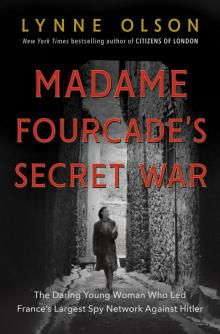 Madame Fourcade's Secret War
Madame Fourcade's Secret War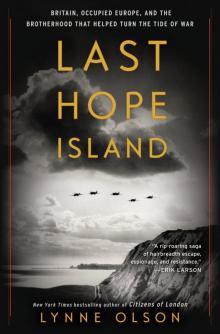 Last Hope Island
Last Hope Island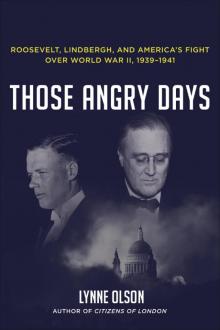 Those Angry Days
Those Angry Days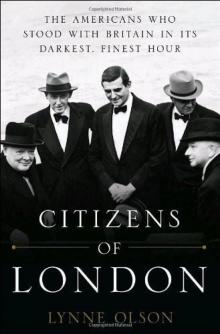 Citizens of London
Citizens of London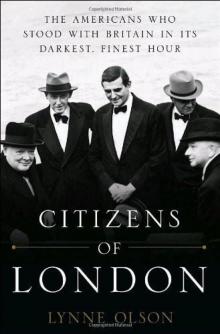 Citizens of London: The Americans Who Stood With Britain in Its Darkest, Finest Hour
Citizens of London: The Americans Who Stood With Britain in Its Darkest, Finest Hour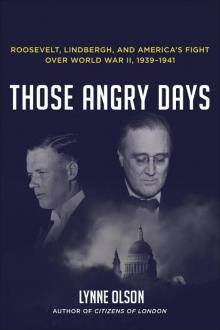 Those Angry Days: Roosevelt, Lindbergh, and America's Fight Over World War II, 1939-1941
Those Angry Days: Roosevelt, Lindbergh, and America's Fight Over World War II, 1939-1941